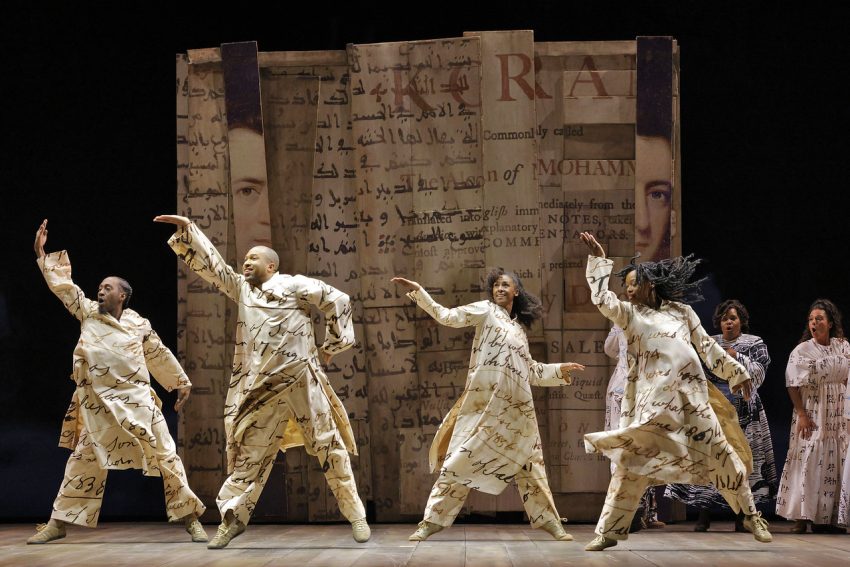
“Omar” Enshrines Words of Muslim Scholar, 50 Years a Slave—at S.F. Opera
Giddens & Abels’ Resonant Rhythms Celebrate Fortitude & Faith
by Barry David Horwitz
We all know that Martin Luther King Jr. wrote his “Letter from a Birmingham Jail” to wake up his fellow ministers about violent segregation in the South. Until now, few of us knew about Omar ibn Said, an Islamic scholar who wrote his “Autobiography” after being abducted from his home in Africa.
Omar was thrown into chains to become a slave for decades in the Carolinas. Both men were prophets, ahead of their times.
At S.F. Opera in November 2023, “Omar” told his story, based on the long-lost memoir. The spectacular Pulitzer Prize winning opera by Rhiannon Giddens and Michael Abels enlists us all in his project. “Omar” recounts both inhuman treatment and comradely joy.
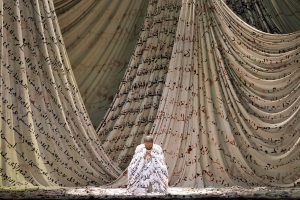
Omar undergoes the horrific Middle Passage, crammed into a ship with other captured Africans, but they have no common language. They cannot share their words or thoughts, only their visible pain and plight. He is isolated, yet surrounded, cut off from communication. In a series of separate scenes, we learn that nothing can break him.
Designers Christopher Myers and Amy Rubin have created spectacular settings for slave raids, the Middle Passage, and a jail cell. They strikingly depict Omar’s life as he is enslaved by one cruel master and another who tries to convert him to Christianity. Powerful Daniel Okulitch plays both slave-owners, underlining their hypocrisy and arrogance.
Jamez McCorkle movingly embodies Omar, who perseveres through decades of trial and torture. His Omar becomes an icon of fortitude, telling the terrible story of isolation and cruelty. McCorkle’s lovely, resonant tenor makes us marvel as Omar questions his slave-owners’ right to trade in flesh and blood. McCorkle makes us believers, as each scene builds our investment in Omar’s transcendance.
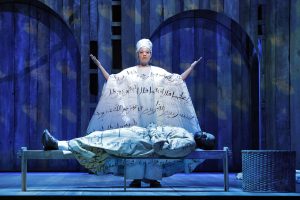
Words from the Qu’ran are written magically on the characters’ robes, as Omar clings to his Islamic origins. His emotions come through in the music, featuring African rhythms, gospel, jazz, folk, and Muslim chants. Giddens and Abels’ cornucopia of music highlights Omar’s faith.
We see a magnificent tree made of intertwined rope rising to dominate the stage. Those intricate cables symbolize the traditions and strength of generations of Africans who were abducted from their homelands. One man’s journey speaks volumes about our history.
Omar’s murdered mother Fatima (lyrical Taylor Raven) counsels him in a dream, from atop a high, flowing blue gown—offering him hope. Elegant costumes by April M. Hickman and Micheline Russell-Brown evoke spiritual sustenance.
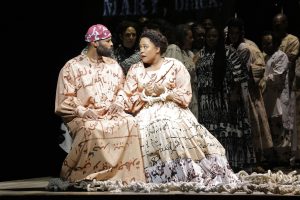
Omar’s friend Julie (inspired Brittany Renee) sings a beautiful second act aria that encourages Omar to outface his oppressors with his words—to write his story. Black joy asserts itself musically, amid oppression. The sheer variety of music and nobility of spirit inspire us to carry Omar’s story to the world.
It’s a religious and a spiritual story—about the generations that were dragged in chains across the sea and sold on the auction block. As the libretto commands: “Tell your story, Omar / Or they will never know.” Told again in stirring music, now we carry on his word.
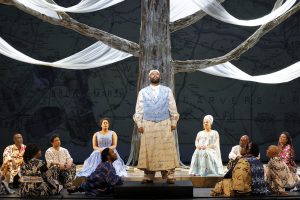
“Omar” –music by Rhiannon Giddens & Michael Abels, libretto by Rhiannon Giddens, directed by Kaneza Schall, conducted by John Kennedy, Opera Chorus directed by John Keene, production design by Christopher Myers, set design by Amy Rubin,
choreography by Kiara Benn, costume design by April M. Hickman & Micheline Russell-Brown, lighting design by Pablo Santiago, projection design by Joshua Higgason, produced by San Francisco Opera. Info: sfopera.com – November 2023.
Cast: Jamez McCorkle, Brittany Renee, Taylor Raven, Daniel Okulitch, Norman Garrett, Laura Krumm, Rehanna Thelwell, and Barry Banks.
Banner photo: Act II dance scene in “Omar.” Photos: Cory Weaver/San Francisco Opera